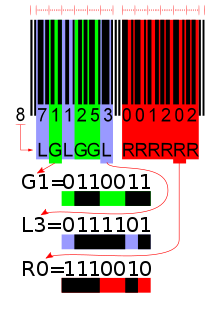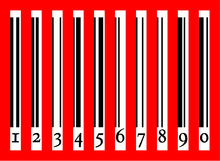国 际商品 编码

另外,
代 码组成 及其意 义[编辑]
- 【EAN
有 8位 数字 和 13位 数字 之 分 】
- 13
位 的 组成是 这样的 :
国家 代 码(前 3位 )[1]生 产商代 码(后 4位 )
- 货品
代 码(再 5位 )
这5
- 计算
机 校 验码(最 后 1位 )
8
- 8
位 的 组成是 这样的 :
国家 代 码(前 3位 )生 产商代 码(后 2位 )
- 货品
代 码(再 2位 )
这2
- 计算
机 校 验码(最 后 1位 )
會員 國 列 表 [编辑]
- 000 - 019

美国 - 020 - 029
Restricted distribution (MO defined) - 030 - 039

美国 - 040 - 049
Restricted distribution (MO defined) - 050 - 139

美国 - 200 - 299
Restricted distribution (MO defined) - 300 - 379

法 國 - 380

保加 利 亚 - 383
 斯洛維尼
斯洛維尼亞 - 385

克 罗地亚 - 387

波 黑 - 389

蒙 特 內哥羅 - 390

科 索 沃 - 400 - 440

德 国 - 450 - 459

日本 - 460 - 469

俄 羅 斯 - 470

吉 尔吉斯斯坦 - 471

臺灣 - 474
 爱沙
爱沙尼 亚 - 475

拉 脫 維亞 - 476

阿 塞 拜 疆 - 477

立 陶 宛 - 478
 乌兹别克斯坦
乌兹别克斯坦 - 479
 斯里
斯里蘭 卡 - 480
 菲律
菲律賓 - 481

白 俄 羅 斯 - 482

烏 克 蘭 - 484

摩 尔多瓦 - 485

亞美 尼 亞 - 486

格 鲁吉亚 - 487
 哈萨
哈萨克 斯坦 - 488

塔 吉 克 斯坦 - 489

香港 - 490 - 499

日本 - 500 - 509

英国 - 520 - 521

希 腊 - 528

黎 巴 嫩 - 529

賽 普 勒斯 - 530

阿 尔巴尼 亚 - 531

北 馬 其頓 - 535

馬 爾 他 - 539
 爱尔兰
爱尔兰 - 540 - 549

比 利 时
盧 森 堡 - 560

葡萄 牙 - 569
 冰島
冰島 - 570 - 579

丹 麦 
法 罗群岛
格 陵 兰 - 590

波 蘭 - 594

羅 馬 尼 亞 - 599
 匈牙
匈牙利 - 600 - 601

南 非 - 603

加 纳 - 604

塞 内 加 尔 - 608

巴 林 - 609

模 里 西 斯 - 611

摩 納 哥 - 613

阿 尔及利 亚 - 615
 奈及
奈及利 亞 - 616
 肯尼亚
肯尼亚 - 618

科 特 迪 瓦 - 617
 喀麦
喀麦隆 - 619
 突尼
突尼西 亞 - 620

坦 桑 尼 亚 - 621

叙 利 亚 - 622

埃及 - 623

文 莱 - 624

利 比 亞 - 625
 约旦
约旦 - 626

伊 朗 - 627

科 威 特 - 628

沙 烏 地 阿 拉 伯 - 629

阿 联酋 - 630
 卡塔尔
卡塔尔 - 637
 苏格兰
苏格兰 - 640 - 649
 芬兰
芬兰 - 690 - 699

中国 - 700 - 709
 挪威
挪威 - 729
 以色
以色列 - 730 - 739

瑞 典 - 740

危地 马拉 - 741
 薩爾
薩爾瓦 多 - 742

洪 都 拉 斯 - 743

尼 加 拉 瓜 - 744
 哥斯达黎
哥斯达黎加 - 745

巴 拿马 - 746

多米 尼 加 - 750

墨 西 哥 - 754 - 755

加 拿大 - 759

委 內瑞拉 - 760 - 769

瑞 士 
列 支 敦 斯登 - 770 - 771
 哥伦
哥伦比 亚 - 773
 乌拉
乌拉圭 - 775

秘 魯 - 777
 玻利维亚
玻利维亚 - 778 - 779

阿 根 廷 - 780

智 利 - 784

巴 拉 圭 - 786

厄 瓜 多 尔 - 789 - 790

巴 西 - 800 - 839

義 大利  圣马
圣马力 诺 梵蒂冈
梵蒂冈 - 840 - 849

西 班 牙 
安 道 尔 - 850

古 巴 - 858
 斯洛
斯洛伐 克 - 859

捷 克 - 860

塞 爾 維亞 - 865

蒙 古 国 - 867

朝 鲜 - 868 - 869

土 耳 其 - 870 - 879

荷 蘭 - 880
 韩国
韩国 - 883

緬 甸 - 884
 柬埔寨
柬埔寨 - 885

泰 國 - 888

新 加 坡 - 890

印度 - 893

越 南 - 896

巴 基 斯坦 - 899

印度 尼 西 亞 - 900 - 919

奥地 利 - 930 - 939
 澳
澳大利 亞 - 940 - 949

新西 兰 - 950
Global Office - 951
Global Office (EPCglobal) - 952
Global Office (Test) - 955
 马来
马来西 亚 - 958

澳門 - 960 - 969
Global Office (GTIN-8s) - 977
期 刊 (ISSN) - 978 - 979
书籍 (ISBN)[a] - 980
退 款收据 - 981 - 984
貨幣 價 值票券 - 990 - 999
印 花 、禮 券
EAN的 背景 [编辑]
早年 [编辑]
更 名 [编辑]
1981
現在 [编辑]
2005
EAN-13 代 码[编辑]
在 条 形 码中的 应用[编辑]
一位数字由两条明线和两条暗线来定义。
四条线段以最细的一条为标准,
编碼的 组成[编辑]




| First digit | First group of 6 digits | Last group of 6 digits |
|---|---|---|
| 0 | LLLLLL | RRRRRR |
| 1 | LLGLGG | RRRRRR |
| 2 | LLGGLG | RRRRRR |
| 3 | LLGGGL | RRRRRR |
| 4 | LGLLGG | RRRRRR |
| 5 | LGGLLG | RRRRRR |
| 6 | LGGGLL | RRRRRR |
| 7 | LGLGLG | RRRRRR |
| 8 | LGLGGL | RRRRRR |
| 9 | LGGLGL | RRRRRR |
This encoding guarantees that the first group always starts with an L-code, which has odd parity, and that the second group always starts with an R-code, which has even parity. Thus, it does not matter whether the barcode is scanned from the left or from the right, as the scanning software can use this parity to identify the start and end of the code.
EAN-8 barcodes encode all digits directly, using this scheme:
| First group of 4 digits | Last group of 4 digits |
|---|---|
| LLLL | RRRR |
| Digit | L-code | G-code | R-code |
|---|---|---|---|
| 0 | 0001101 | 0100111 | 1110010 |
| 1 | 0011001 | 0110011 | 1100110 |
| 2 | 0010011 | 0011011 | 1101100 |
| 3 | 0111101 | 0100001 | 1000010 |
| 4 | 0100011 | 0011101 | 1011100 |
| 5 | 0110001 | 0111001 | 1001110 |
| 6 | 0101111 | 0000101 | 1010000 |
| 7 | 0111011 | 0010001 | 1000100 |
| 8 | 0110111 | 0001001 | 1001000 |
| 9 | 0001011 | 0010111 | 1110100 |
Note: Entries in the R-column are bitwise complements (logical operator: negation) of the respective entries in the L-column. Entries in the G-column are the entries in the R-column in reverse bit order. See pictures of all codes against a colored background.
A run of one or more black areas is known as a "bar", and a run of one or more white areas is known as a "space". As can be seen in the table, each digit's encoding comprises two bars and two spaces, and the maximum width of a bar or space is four areas.
校 驗 碼的計算 方法 [编辑]
例 子 :假設 某 國際 商品 條 碼的前 12位 是 :490-8569-21968;計算 加 權 和 :校 驗 碼即為 加 權 和 除 以 10的 負 餘 數 :。
外部 連結 [编辑]
- (
英文 )GS1 (页面存 档备份,存 于互联网档案 馆) - (简体
中 文 )GS1 China中 华人民 共和 国 物品 编码中心 (页面存 档备份,存 于互联网档案 馆) - (
中 文 )GS1 Taiwan財團 法人 中華民國 商品 條 碼策進 會 (页面存 档备份,存 于互联网档案 馆) - (
中 文 )GS1 Hong Kong香港 貨品編 碼協會 (页面存 档备份,存 于互联网档案 馆) - (
中 文 )GS1 Macau澳門 (页面存 档备份,存 于互联网档案 馆) - (
英文 )GS1 Singapore新 加 坡 (页面存 档备份,存 于互联网档案 馆) - (
英文 )BarcodeRobot (页面存 档备份,存 于互联网档案 馆)
參考 來 源 [编辑]
註釋
- ^ 979-0
特 意 留 空 ,給 予 國際 標準 音樂 出版 物 編 碼(ISMN)使用 。
引用
- ^ Prefix List, GS1, [2017-01-03], (
原始 内容 存 档于2014-12-28). - ^ Alumni Hall of Fame Members. University of Maryland Alumni Association. The University of Maryland. 2005 [2009-06-10]. (
原始 内容 存 档于2007-06-23).After graduating from Maryland in 1951, George Laurer joined IBM as a junior engineer and worked up the ranks to senior engineer. In 1969, he returned to the technical side of engineering and was later assigned the monumental task of designing a code and symbol for product identification for the Uniform Grocery Product Code Council. His solution — the Universal Product Code — radically changed the retail world. Since then, he has enhanced the code by adding a 13th digit. Laurer retired from IBM in 1987. He holds some 25 patents and is a member of the university’s A. James Clark School of Engineering Hall of Fame.
- ^
商品 條 碼發起人 Alan Haberman與 世 長 辭 . Unwire.hk. 2011年 6月 17日 [2017-01-03]. (原始 内容 存 档于2017-01-04). - ^ MARGALIT FOX. 现代
条 形 码发明 者 伍 德 兰去世 . 纽约时报中 文 网. 2012年 12月17日 [2017-01-03]. (原始 内容 存 档于2017-01-04). ([//web.archive.org/web/20170104000906/http://cn.nytimes.com/obits/20121217/c17woodland-obit/zh-hant/ 页面存 档备份,存 于互联网档案 馆) (页面存 档备份,存 于互联网档案 馆) (页面存 档备份,存 于互联网档案 馆) (页面存 档备份,存 于互联网档案 馆) (繁 體 中 文 )] (页面存 档备份,存 于互联网档案 馆)
| |||||||||||||||||||||||||||||||||||||||||||||||||||




